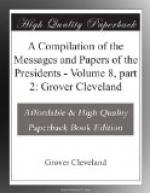But this ignorance of the subject seems incredible. A railroad from St. Andrews to Quebec would be impossible unless it crossed the territory in question, even next to impossible and totally useless were it to pass at the north of the St. John. It seems, therefore, extraordinary indeed that the British Government, even in the incipient stages of this enterprise, should make an appropriation which is in direct violation of its solemn pledge. To give to a railroad corporation powers over our rights and property is the strongest act of sovereignty. It is an act of delegated power which we ourselves give to our own citizens with extreme caution and with guarded restrictions and reservations. This railroad must not only cross the disputed territory, but it crosses it 50 miles south of the St. John and almost to the southerly extremity of the British claim, extravagant as it is. By the map herewith exhibited of the survey of the route it appears that the road crosses our due north line at Mars Hill, thence doubling round it toward the south it crosses the Roostic between the Great and Little Machias, the Allegwash at the outlet of First Lake, a branch of the St. John south of Black River, and passes into Canada between “Spruce Hills” on the right and “Three Hills” on the left, thus crossing a tract of country south of the St. John 100 by 50 miles. We have not a copy of the act of incorporation of New Brunswick, and can not, therefore, say that the route there defined is the same as on the map. Be this as it may, certain it is, as anyone will see, that no possible route can be devised which will not cross the territory in question. It is, then, a deliberate act of power, palpable and direct, claiming and exercising sovereignty far south even of the line recommended by the King of the Netherlands.
In all our inquiries and examinations of this subject there has been great negligence in regard to this northwest angle. Judge Benson, one of the commissioners under Jay’s treaty, in a letter to the President of the United States expressly and clearly defines this angle. He states distinctly that the due north line from the source of the St. Croix is the west-side line, and the highlands are the north-side line which form this angle, and this had never been questioned by the British themselves.
This due north line, viz, the west-side line, was established by the commission of which Judge Benson was a member, and the British have made the north side line to be north of the Bay de Chaleurs, and yet with these postulates to pretend that the points of intersection can not be found is one of the greatest of their absurdities; and another absurdity quite equal is that after passing west along the north shore of this bay they would fall down nearly south more than 100 miles to Mars Hill, about 60 miles from the south shore of the Province, at the Bay of Passamaquoddy, which is part of the Bay of Fundy, and this point, too, of so little inclination that it is a palpable perversion of language to call it an angle, much more a northwest angle.




